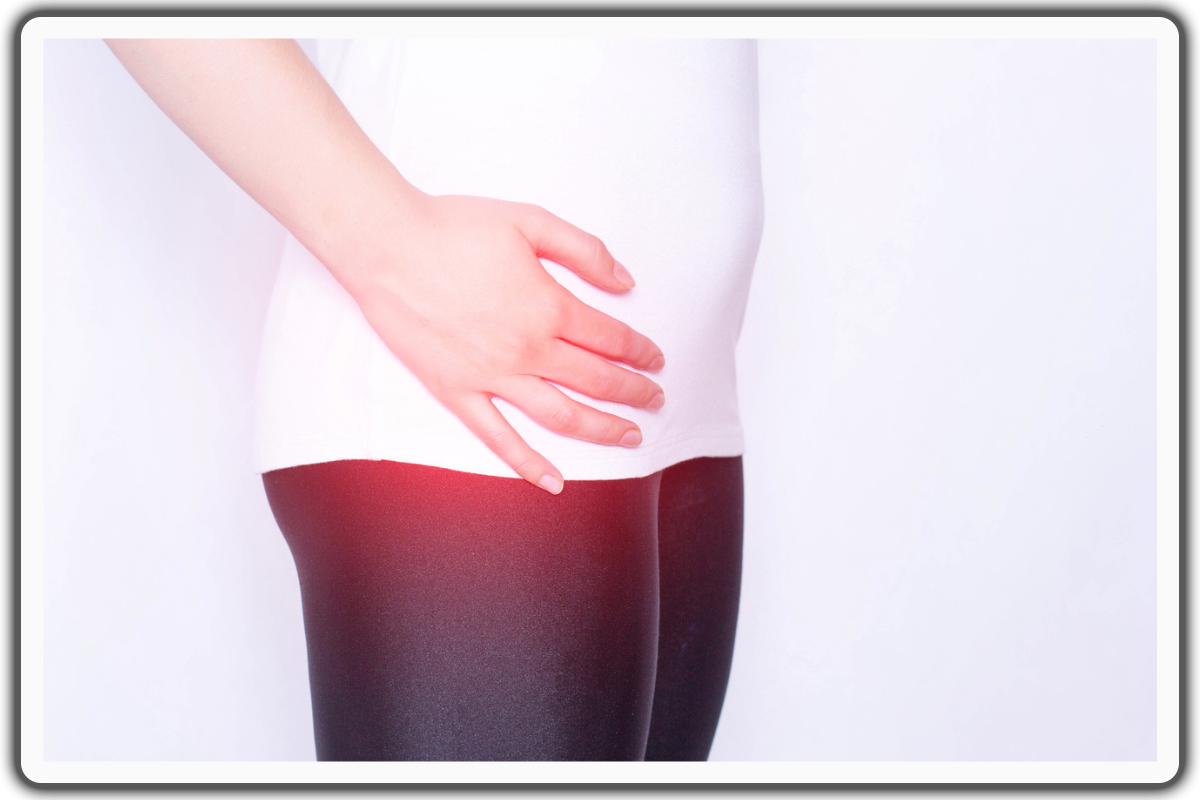
Hip Pain SOS: Break Free from Prolonged Sitting Discomfort!
Sick and tired of being held hostage by your own hips due to endless hours of sitting? Welcome to your hip liberation headquarters, the Hip Pain SOS!
In this modern era of sedentary living, we’ve all become sitting sloths, whether it’s glued to our office chairs, couches, or even car seats during commutes. And many would agree that all that sitting is wreaking havoc on our poor hips, leaving us in agony.
But worry no more, for we’ve got the antidote to your hip pain woes! We’ve assembled the ultimate guide to help you bust free from the clutches of discomfort and take back control of your life. Aren’t you excited to say goodbye to the tyranny of hip pain?
So fasten your seatbelts and say hello to a pain-free future filled with fun and freedom!
Why does my hip hurt from sitting for long periods?
Hip pain when sitting for prolonged periods is attributed to various reasons.
1. Pressure on hip joints: The hip joint is a ball-and-socket joint, and when you sit for extended periods, the weight of your upper body puts more pressure on the hip socket, compressing the cartilage and tissues. Over time, these muscles become tense and tight, leading to discomfort and pain.
2. Hip Flexor Tightness: Sitting for long hours can cause your hip flexor muscles to become tight and shortened. Tight hip flexors can pull on the hip joint and lead to discomfort.
3. Reduced Blood Flow: Sitting for too long can impede blood flow to the hips, depriving the muscles and tissues of essential nutrients and oxygen. This reduced blood flow can contribute to muscle fatigue and pain.
4. Poor Posture: Maintaining a slouched or improper sitting posture can place additional stress on your hips and lower back. Poor posture can affect the alignment of your spine and hips, leading to discomfort and pain, back pain included.
5. Hip Joint Inactivity: When you sit for an extended period, your hip joint remains in a fixed position, limiting its range of motion. Inactivity can lead to stiffness and discomfort in the hip joint.
6. Muscle Weakness: Sitting excessively can lead to weakened hip muscles. Weaker muscles may struggle to support your hips properly, resulting in pain and instability.
Effective Strategies to Alleviate Hip Pain Due to Sitting for Long Hours
Here are effective strategies to relieve hip pain and get you back on track!
1. Incorporate Regular Breaks
Take regular breaks and incorporate movement into your daily routine. Sitting for long periods of time can cause stiffness and tightness in the hip muscles. Short breaks every hour or so allow your hips to stretch and relax. Simple exercises like standing up and doing a few stretches or taking a short walk can go a long way toward relieving hip pain.
2. Invest in an Ergonomic Chair to Maintain Proper Posture
Using proper ergonomics when sitting for extended hours is also an effective strategy. This means ensuring that your chair and desk are at the correct height and that you’re sitting with good posture. An ergonomic chair with lumbar support and adjustable height can help alleviate pressure on the hips and lower back. It’s also important to position your computer screen at eye level to avoid straining your neck and upper back.
Also, avoid crossing your legs when sitting. Sitting with crossed legs exacerbates hip pain by putting additional strain on the hips. Try to keep both feet flat on the floor, or use a footrest if needed.
3. Engage in Low-impact Hip Exercises
Adding hip-strengthening exercises to your fitness routine can also alleviate hip pain. Exercises such as hip bridges, squats, and lunges can help strengthen the surrounding muscles of the hip joint. This reduces pain and provides added support for your hips.
Exercises that Prevent Pain in the Hip When Sitting
Here are 4 exercises to relieve and prevent hip pain when sitting for many hours every day.
1. Supine Knee-To-Chest
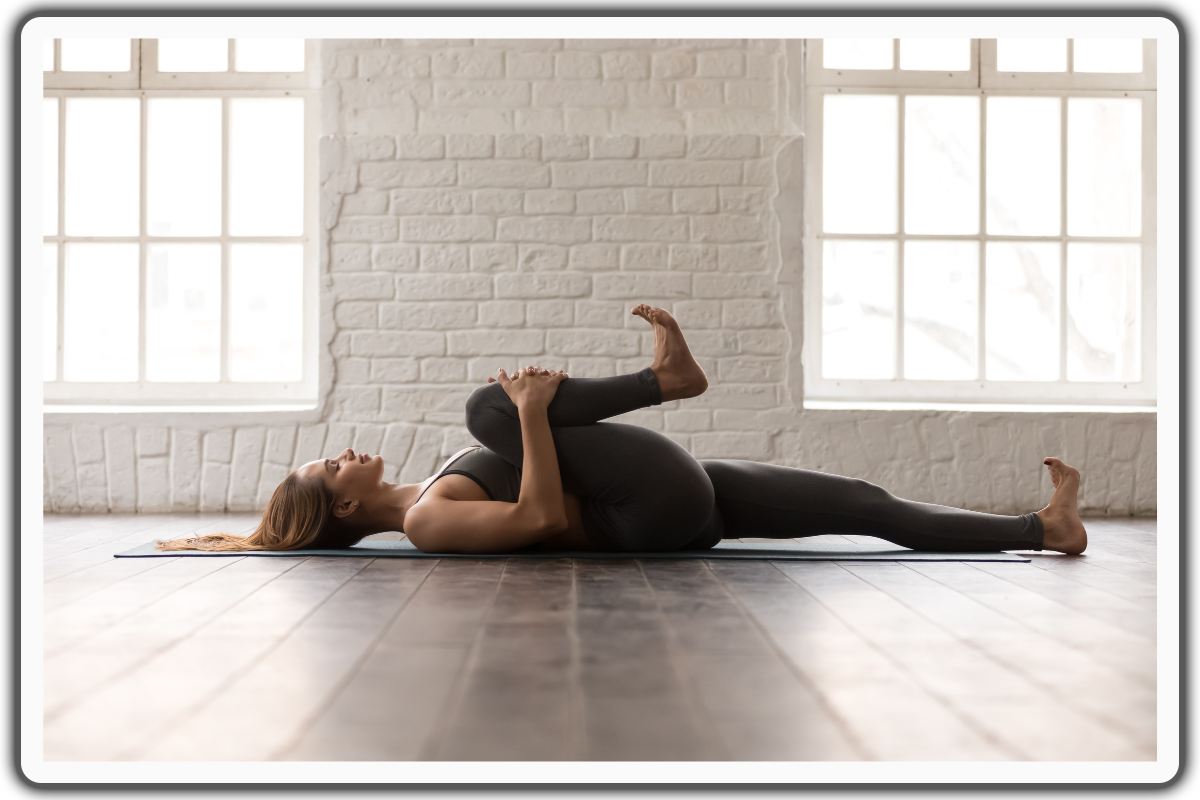
This stretch helps release tension in the lower back and hip muscles.
To begin, lie on your back on the floor or bed with your legs extended and arms at your sides. Now raise your right knee and hold your shin with both hands while you pull it more towards your chest to stretch it. Hold this position for 30 seconds before releasing it and returning it to the starting position. Complete 3 repetitions of 1-2 sets. Repeat the sequence of movements on the opposite leg.
2. Reclining Angle Bound Pose
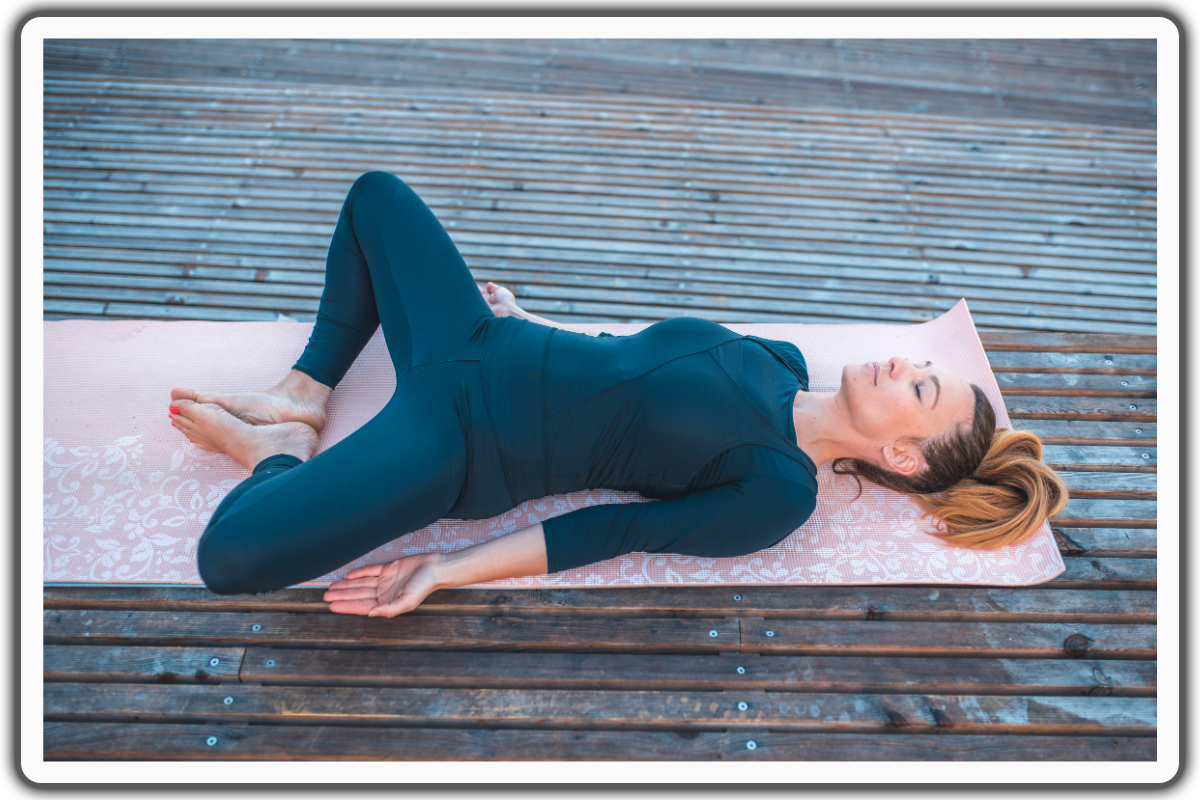
Also known as Supta Baddha Konasana, this pose helps open up the hips, groin, and chest, relieving tight muscles in the hips.
To begin, lie on your back on the floor or bed with your legs extended and arms at your sides. Put the soles of your feet together, then slowly open your knees on the side until you feel a gentle stretch on your groin. Hold this position for 30 seconds before releasing it and returning it to the starting position. Complete 3 repetitions of 1-2 sets.
3. Kneeling Side Bend Stretch
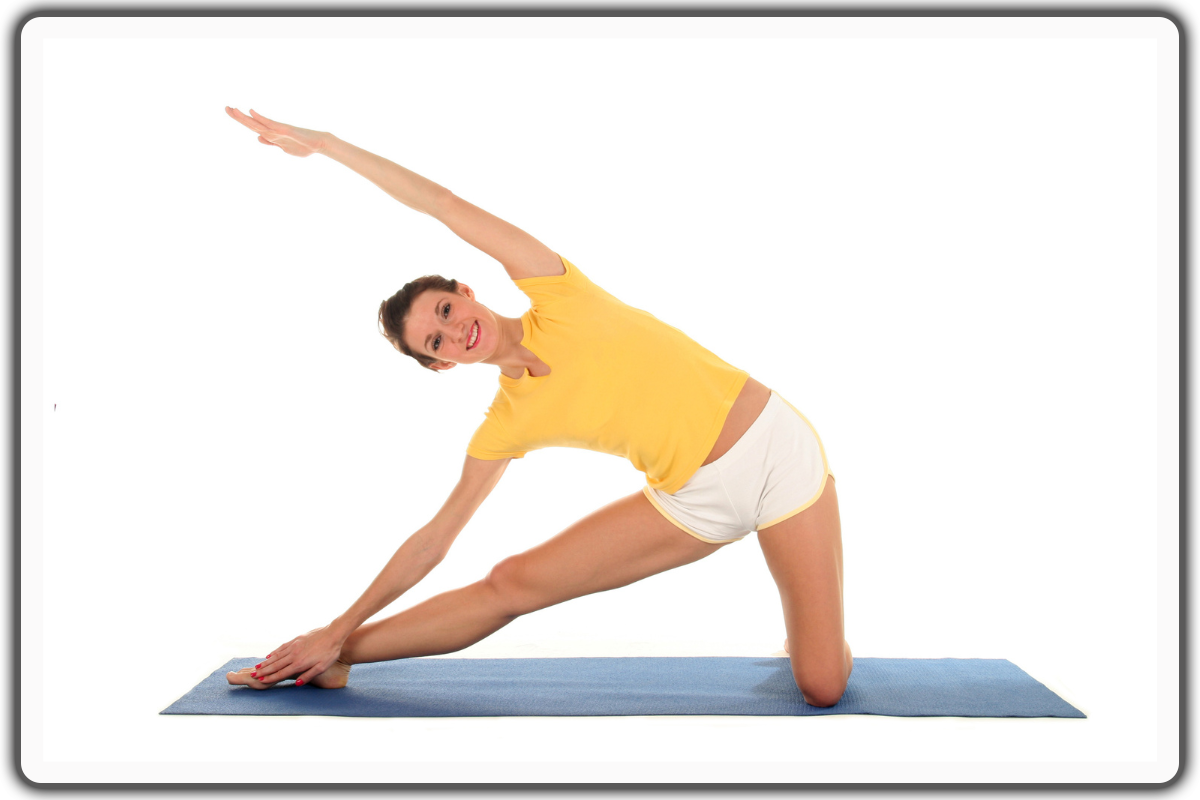
This stretch helps release tension in the hips and side muscles.
Start doing this stretch by kneeling on the floor with your knees slightly away from each other. Make sure your back is properly aligned. With your core engaged, extend your left leg on the side perpendicular to your body with your toes pointing to the floor. Then extend your left arm over your head while slowly bending your torso to the right side until you feel a gentle stretch on your hip. Hold this position for 30 seconds before releasing it and returning it to the starting position. Complete 3 repetitions of 1-2 sets. Then repeat the sequence of movements on the opposite side.
4. Lunging Hip Flexor Stretch
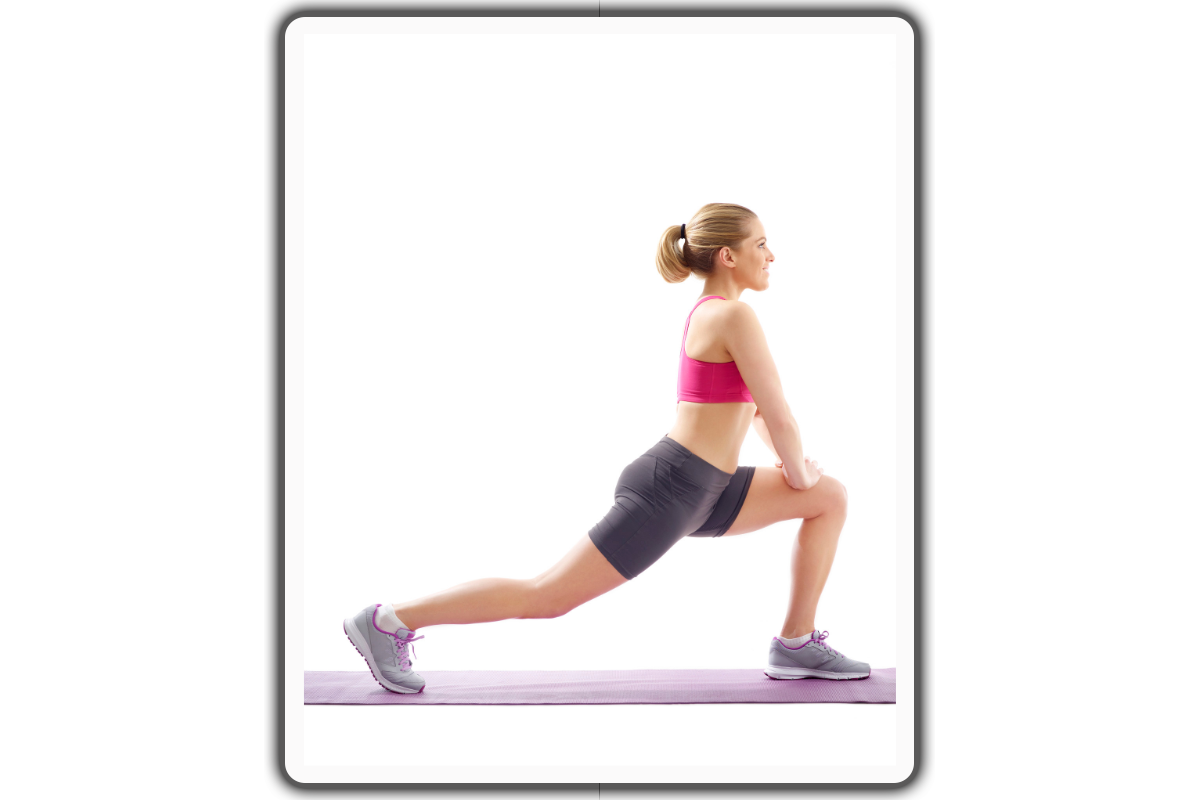
A Lunging Hip Flexor Stretch helps improve hip flexibility and reduce tightness in the hip muscles.
Start in a forward lunge position by bending your left knee at a 90-degree angle and keeping your right leg straight behind you. Now drive your hips forward until you feel a gentle stretch from the front of your hip, groin, and thigh on your right side. Hold this position for 30 seconds before releasing it and returning to the starting position. Complete 3 repetitions of 1-2 sets. And repeat the sequence of movements on the opposite side.
Try these strategies now! Soon you’ll be amazed at how they alleviate your hip pain and lead you to a life of greater ease and mobility.
The Impact of Ignoring Hip Pain When Sitting

Ignoring hip pain when sitting can lead to various negative consequences for your health and well-being.
Here are some reasons why you should not ignore hip pain when sitting:
1. Underlying Health Issues: Hip pain when sitting can be a symptom of an underlying health problem, such as arthritis, bursitis, or hip impingement. Ignoring the pain may delay the proper diagnosis and treatment of these conditions, potentially leading to further complications.
2. Chronic Hip Pain: Ignored hip pain can become chronic and persistent, affecting daily activities, mobility, and overall quality of life. A chronic condition of hip pain can also contribute to increased stress and mental health issues.
3. Limited Mobility: Hip pain may restrict your ability to move freely, making it challenging to perform regular tasks and exercise. This lack of mobility can lead to muscle weakness and joint stiffness.
4. Worsening of Condition: If the underlying cause of hip pain is not addressed, the condition may worsen over time, leading to more severe pain and reduced functionality.
5. Negative Impact on Posture: Pain can alter your posture and movement patterns as you try to avoid aggravating the discomfort. This altered posture may lead to imbalances in other parts of your body, causing additional aches and pains.
6. Decreased Quality of Life: Persistent hip pain can significantly impact your daily life, making it difficult to enjoy activities you once loved. This can lead to feelings of frustration, isolation, and reduced overall happiness.
7. Risk of Complications: Certain conditions causing hip pain, such as hip labral tears or hip fractures, may require surgical intervention if left untreated. Ignoring the pain can increase the risk of complications and more invasive treatments.
8. Missed Opportunities for Early Intervention: Addressing hip pain early allows for timely intervention, which may include conservative treatments like physical therapy, lifestyle modifications, or medication, reducing the need for more invasive procedures later.
9. Longer Recovery Time: Delaying treatment for hip pain can lead to a longer recovery period, as the condition may progress and become more challenging to manage.
Remember, identifying the underlying cause of hip pain when sitting promptly helps your hips feel better while working and sitting for long hours
Action to Take
Take charge of your hip health and address the discomfort that your hip hurts from sitting all day situation brings. Armed with the knowledge and effective strategies to combat hip pain from prolonged sitting, you're well on your way to a pain-free and mobile lifestyle.
Consistency is key, so keep stretching, moving, and incorporating those microbreaks into your daily routine. Embrace these positive changes, and soon you'll bid farewell to discomfort caused by hip pain, welcoming a future filled with newfound comfort and vitality.
FAQs
What are the most common causes of hip pain?
Hip pain is a common complaint that affects people of all ages. Various factors can cause hip pain.
1. Prolonged Sitting: Staying seated for extended periods can cause hip pain because it puts pressure on the hip joints.
2. Arthritis: This condition is the leading cause of hip pain. Arthritis, such as Hip Osteoarthritis or Rheumatoid Arthritis, can cause hip pain due to the inflammation and degeneration of the hip joint.
3. Hip Bursitis: An inflammation of the bursae is called Bursitis. Bursae (bursa) are small, fluid-filled sacs that cushion the hip joint. Repetitive movements or prolonged pressure on the hip can lead to bursitis.
4. Muscle Strains: These strains can be caused by overuse, sudden movements, or excessive physical activity. Muscle strain can occur in the surrounding muscles of the hip joint.
5. Tendinitis: Refers to the inflammation of the tendons in the hip, which can cause hip pain. Overuse or muscle imbalances or sudden injuries lead to tendinitis in the hip area.
6. Hip Fracture: Typically caused by trauma or falls, hip fractures also cause hip pain, especially in older adults.
7. Sciatica: This condition is characterized by compression or irritation of the sciatic nerve, causing hip pain. The sciatic nerve runs from the lower back down to the legs.
Understanding the causes helps you take appropriate measures to alleviate and prevent hip pain.
What are hip flexors?
Hip flexors are a group of muscles located in the front of the hip joint. They play a crucial role in everyday movements such as walking, running, and bending. The primary function of hip flexors is to flex the hip joint, which means bringing the thigh towards the chest.
The main hip flexor muscles include the iliopsoas, rectus femoris, and sartorius. These muscles work in coordination with each other to provide stability and support for the hip joint. Tight or weak hip flexors can lead to various issues, such as low back pain, hip pain, and limited range of motion. Stretching and strengthening exercises help maintain the flexibility and strength of the hip flexors.
What should you do if you’re experiencing hip pain when sitting?
If you frequently experience hip pain when sitting, it's essential to identify the underlying causes and seek appropriate treatment to improve your overall hip health. The first step is to make an appointment with a healthcare professional, such as a doctor or physical therapist, who can evaluate your symptoms and provide a diagnosis. They can help determine the cause of your hip pain and recommend appropriate treatment options.
Healthcare professionals often work with you to develop a personalized treatment plan, depending on the severity of the pain. Your doctor may refer you to a specialist, such as an orthopedic surgeon or a physical therapist. Treatment options vary, from strengthening hip exercises and stretches to other techniques that provide targeted care. Various medical techniques to reduce pain and improve your mobility include massage therapy, heat therapy, and physiotherapy.
Hip pain can be a sign of a more serious underlying condition, so it should not be ignored. It is important to address hip pain promptly, especially if it is chronic, to prevent further complications.
